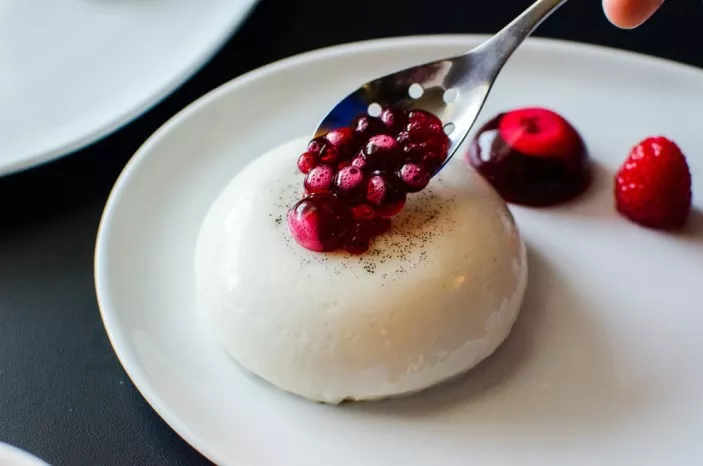Coconut panna cotta is a delightful and luxurious dessert that has gained immense popularity in recent years. This Italian-inspired treat combines the rich, creamy texture of traditional panna cotta with the tropical essence of coconut. While panna cotta itself is a well-loved classic, the infusion of coconut elevates it to a whole new level of indulgence. In this article, we will dive deep into the world of coconut panna cotta, exploring its origins, ingredients, preparation, and variations.
The Origins of Panna Cotta
Panna cotta, a term that literally translates to “cooked cream” in Italian, has its roots in the northern regions of Italy, particularly in Piedmont. It is a dessert known for its simplicity and versatility. The basic panna cotta is made with just a few ingredients: cream, sugar, and gelatin, resulting in a velvety, custard-like texture.
The concept of panna cotta is believed to have evolved from traditional Italian recipes for crema cotta, a simple cooked cream dessert. Over time, it has been adapted and transformed into a myriad of variations, including fruit-infused, chocolate, and, of course, the beloved coconut panna cotta.
What Sets Coconut Panna Cotta Apart
Coconut panna cotta is a tropical twist on the classic Italian dessert. It retains the fundamental elements of traditional panna cotta while introducing the creamy, exotic flavor of coconut. This infusion brings a delightful balance of sweetness and a hint of the tropics to the palate.
The key to creating an exceptional coconut panna cotta lies in the use of high-quality coconut milk. The creaminess and distinct coconut flavor of the milk are what make this dessert stand out. While coconut panna cotta still includes sugar and gelatin, it is the coconut milk that takes center stage.
Ingredients for Coconut Panna Cotta
Creating the perfect coconut panna cotta requires a few essential ingredients:
1. Coconut Milk: The star of the show, coconut milk, forms the base of the dessert. Opt for full-fat coconut milk for the creamiest and most flavorful results. It’s advisable to use a brand that offers a consistent, high-quality product.
2. Sugar: Sugar provides the sweetness needed to balance the rich coconut flavor. The amount of sugar can be adjusted to suit your preference, but it’s typically included in moderate amounts.
3. Gelatin: Gelatin is used to set the panna cotta, giving it the characteristic firm yet creamy texture. Unflavored powdered gelatin is the most common choice for this purpose.
4. Vanilla Extract: A touch of vanilla extract enhances the overall flavor profile, complementing the coconut’s natural sweetness.
5. A Pinch of Salt: A tiny pinch of salt helps enhance the flavors, balancing the sweetness and enhancing the depth of the coconut’s taste.
How to Make Coconut Panna Cotta
Creating a luscious coconut panna cotta is a straightforward process, and the result is a dessert that is as beautiful as it is delicious.
1. Bloom the Gelatin: To begin, sprinkle the powdered gelatin over cold water in a bowl and allow it to “bloom” for about 5-10 minutes. This softens the gelatin and prepares it for mixing.
2. Heat the Coconut Milk: In a saucepan, combine the coconut milk and sugar. Heat the mixture over medium heat, stirring until the sugar has dissolved and the coconut milk is hot but not boiling.
3. Combine the Gelatin and Coconut Milk: Add the bloomed gelatin to the hot coconut milk and stir until the gelatin dissolves completely. Make sure there are no lumps.
4. Add Vanilla and Salt: Stir in the vanilla extract and a pinch of salt, enhancing the flavor of the coconut panna cotta.
5. Pour into Molds: Pour the mixture into individual serving molds or glasses. These can be anything from ramekins to decorative glasses, depending on your preference.
6. Chill: Place the molds in the refrigerator and let them set for at least 4-6 hours, or preferably overnight. The panna cotta should have a firm, custard-like consistency when fully set.
7. Serve: To serve, you can enjoy the coconut panna cotta directly in the molds or unmold it onto a plate. Garnish with fresh fruit, a drizzle of fruit compote, or a sprinkle of shredded coconut for added flair.
Variations of Coconut Panna Cotta
Coconut panna cotta offers a wonderful canvas for creativity in the kitchen. Here are some exciting variations that you can explore:
1. Mango Coconut Panna Cotta: Add the vibrant flavor of mango by layering a mango puree or compote beneath the coconut panna cotta. The combination of creamy coconut and sweet, tangy mango is a tropical delight.
2. Passion Fruit Coconut Panna Cotta: Introduce a zesty twist by drizzling passion fruit pulp or syrup over your coconut panna cotta. The tartness of passion fruit complements the sweetness of coconut beautifully.
3. Pineapple Coconut Panna Cotta: Create a tropical paradise on your plate by adding pineapple chunks or pineapple compote to your coconut panna cotta. This adds a delightful textural contrast.
4. Chocolate Coconut Panna Cotta: For chocolate lovers, you can include cocoa powder or melted chocolate to infuse your coconut panna cotta with a rich cocoa flavor. It’s a delightful combination for those who enjoy the interplay of coconut and chocolate.
5. Berry Coconut Panna Cotta: Top your coconut panna cotta with a mixed berry compote or a selection of fresh berries. The bright, tangy flavors of the berries contrast beautifully with the creaminess of the coconut.
6. Nutty Coconut Panna Cotta: Garnish your coconut panna cotta with chopped toasted nuts such as almonds, pistachios, or macadamia nuts. The nuts add a pleasant crunch and a nutty undertone to the dessert.
Conclusion
Coconut panna cotta is a delightful and luxurious dessert that combines the creaminess of traditional Italian panna cotta with the exotic allure of coconut. Its origins in Italy have paved the way for creative variations that can tantalize the taste buds in numerous ways.























